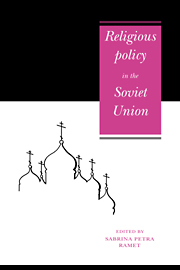Book contents
- Frontmatter
- Contents
- Notes on contributors
- Preface
- Part I Introduction
- 1 A survey of Soviet religious policy
- 2 Religious policy in the era of Gorbachev
- Part II Policy apparatus
- Part III Education, socialisation, and values
- Part IV Cults and sects
- Part V The world of Christianity
- APPENDIX: Religious groups numbering 2,000 or more, in the USSR
- Index
1 - A survey of Soviet religious policy
Published online by Cambridge University Press: 03 December 2009
- Frontmatter
- Contents
- Notes on contributors
- Preface
- Part I Introduction
- 1 A survey of Soviet religious policy
- 2 Religious policy in the era of Gorbachev
- Part II Policy apparatus
- Part III Education, socialisation, and values
- Part IV Cults and sects
- Part V The world of Christianity
- APPENDIX: Religious groups numbering 2,000 or more, in the USSR
- Index
Summary
The first 70 years of Soviet power saw a sustained offensive against religion on a scale unprecedented in history. Millions suffered and died. There is a great deal of descriptive and anecdotal material about these sufferings readily available, and I do not propose to reproduce much of it here. My task in this chapter is to present the frame of reference within which the anti-religious offensive took place, showing what the legal and constitutional situation was, what was actual policy at any given time (the two only rarely match), or (more often) the failure of the various strategies and tactics.
The CPSU has always been dedicated to promoting the disappearance of religion, but the formation and execution of a religious policy has usually been subordinate to, and influenced by, other constantly changing political, economic, and social considerations. Any attempt to subdivide Soviet religious policy into successive chronological phases tends, therefore, to be contentious, since exceptions to the general norm at any date are always to be found, and within any chosen phase there are policy modifications and even reversals. Nevertheless, just this kind of chronological approach is what I propose to attempt. Within each chronological section I shall first consider official policy towards religious institutions and towards individual believers, showing where toleration ended and discrimination began; and then I shall look at what efforts were being made in the field of anti-religious education and propaganda.
Before moving on to the chronological survey, however, I shall briefly consider some of the basic motives which have influenced those responsible for shaping Soviet religious policy, and the institutional framework within which such policy was developed.
- Type
- Chapter
- Information
- Religious Policy in the Soviet Union , pp. 3 - 30Publisher: Cambridge University PressPrint publication year: 1992
- 3
- Cited by

